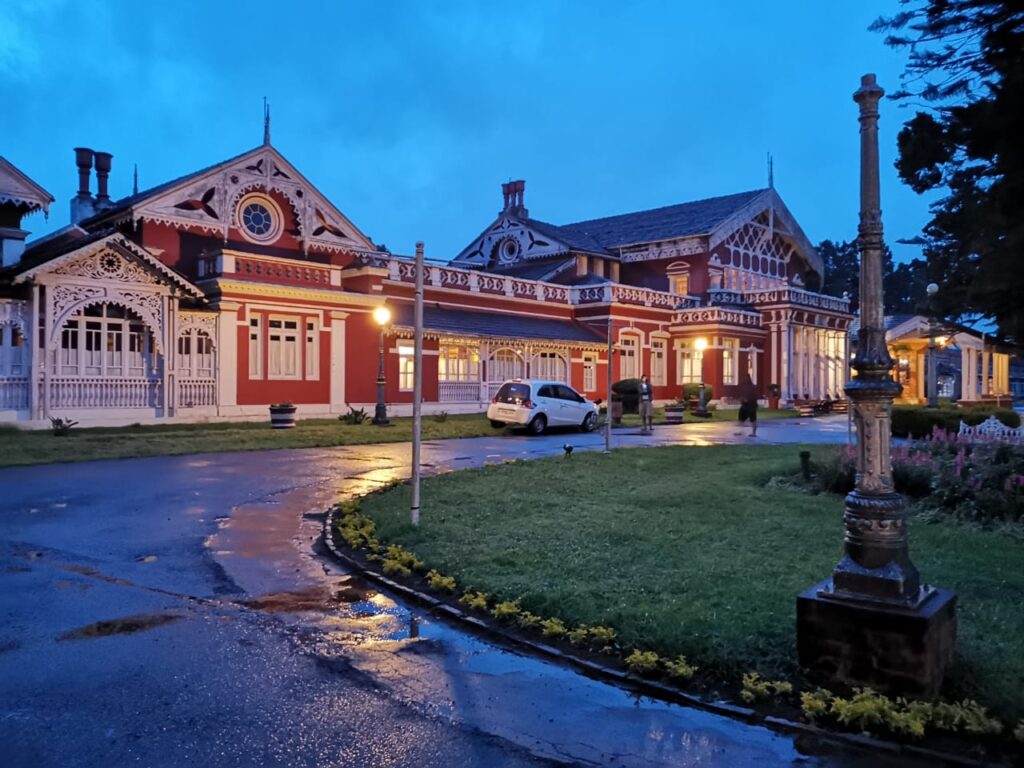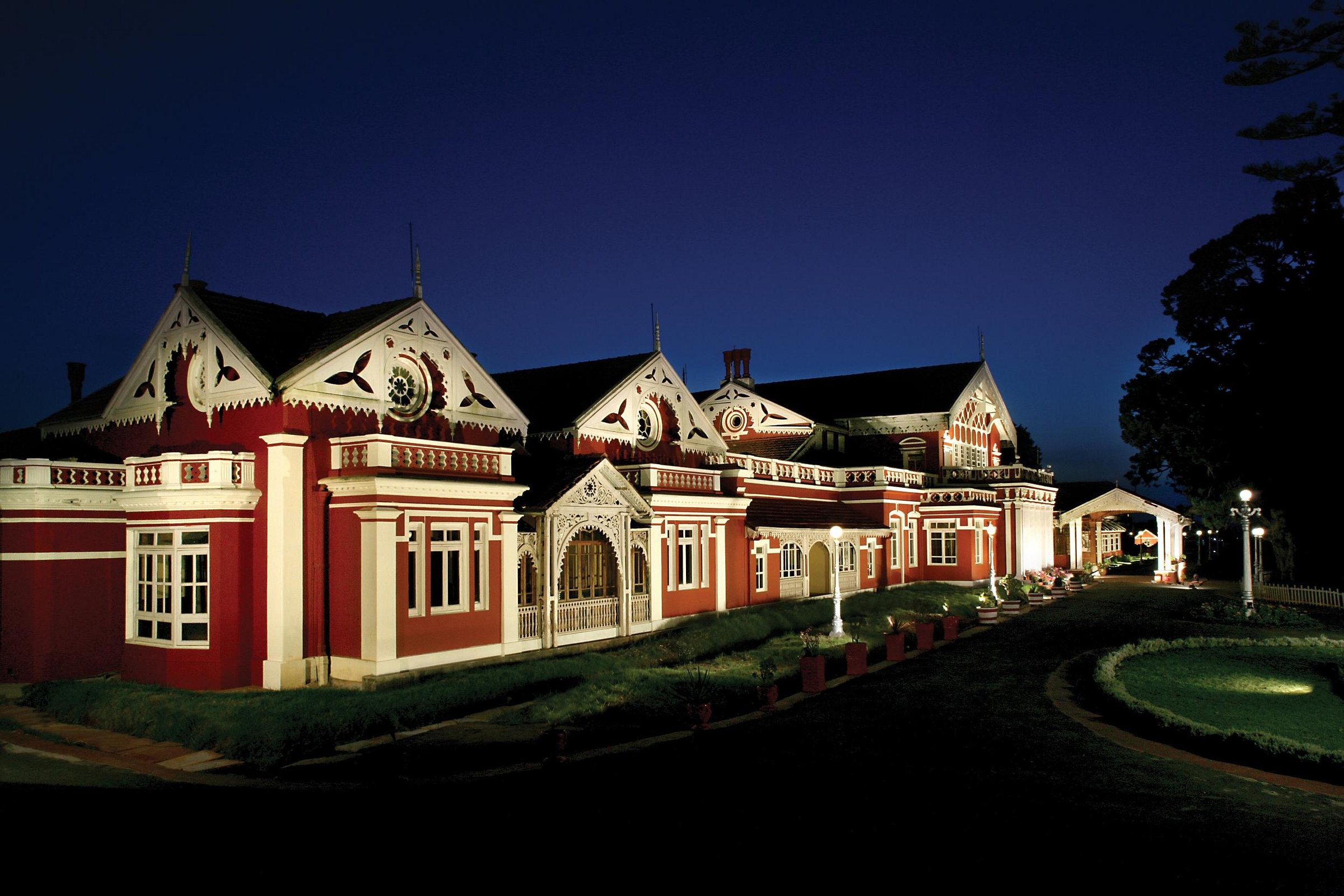A Haunted Tale of Grief and Mystery
Nestled amidst the misty Nilgiri Hills in Ooty, Tamil Nadu, Fernhill Palace stands as a majestic relic of colonial grandeur and royal legacy. Built in 1844 as a summer retreat for the Maharaja of Mysore, this Swiss chalet-style palace, now a WelcomHeritage luxury hotel, is renowned for its sprawling 50-acre estate, Burmese teak interiors, and breathtaking views of the “Queen of Hill Stations.” Yet, beneath its opulent facade lies a chilling legend: The Weeping Widow of Fernhill Palace, a ghostly figure said to wander its corridors, her sobs echoing through the night. Known as one of India’s most haunted places, Fernhill’s eerie reputation draws thrill-seekers, ghost hunters, and curious travelers. In this blog, we unravel the haunting tale of the Weeping Widow, explore the palace’s storied past, and reveal why this Ooty landmark is a must-visit for those daring to uncover its mysteries.
Fernhill Palace: A Royal Retreat with a Haunted Past
Constructed in 1844 by Captain F. Cotton, Fernhill Palace began as a colonial bungalow before being acquired by the 12-year-old Maharaja of Mysore in 1873. Serving as the Maharaja’s summer residence, the palace, with its carved wooden bargeboards, ornamental cast iron, and manicured gardens, became a haven for British elites escaping South India’s heat during the British Raj. In the 1920s, it was converted into Fern Hill Hotel, and by the 1990s, it transformed into a luxury heritage resort under WelcomHeritage, boasting 19 opulent suites, a multi-cuisine restaurant, and a grand ballroom with a papier-mâché ceiling.
Located at Fernhills Post, 2 km from Ooty’s railway station and bus stand, the palace is surrounded by tea gardens and cardamom plantations, offering easy access to attractions like Ooty Lake and Botanical Gardens. Despite its beauty, the palace’s poor maintenance—creaky wooden floors, water seepage, and non-functional fireplaces—adds to its eerie ambiance, fueling tales of paranormal activity. Its haunted reputation surged in 2002 during the filming of Bollywood’s Raaz, when choreographer Saroj Khan reported inexplicable noises, cementing Fernhill’s place in India’s spooky lore.
The Legend of the Weeping Widow
The Weeping Widow is a poignant figure in Fernhill Palace’s haunted tapestry, her story woven from Ooty’s colonial and royal history. Local folklore tells of Elizabeth Harrow, a British officer’s wife who resided at Fernhill in the late 19th century during its time as a British retreat. Married to Captain James Harrow, Elizabeth was known for her beauty and grace, often hosting lavish balls in the palace’s ballroom. Tragedy struck when James was killed in a skirmish during the 1857 Sepoy Mutiny, leaving Elizabeth heartbroken. Overcome by grief, she secluded herself in a suite overlooking the Nilgiri Hills, where she was later found dead—some say by suicide, others claim under mysterious circumstances, possibly at the hands of a jealous rival or colonial intrigue.
Elizabeth’s spirit, dubbed the Weeping Widow, is said to haunt Fernhill Palace, her sorrowful cries heard on full moon nights. Guests report seeing a woman in a flowing white gown, her face veiled, wandering the ballroom or standing by the suite’s window, sobbing softly. Her presence is often accompanied by cold spots, flickering lights, or the sound of a piano playing in the empty lounge. Some believe her spirit is tied to the palace’s rumored burial ground origins or its history of mistreatment during construction, amplifying her restless energy. The widow’s appearances are most frequent in Room 13, a suite notorious for paranormal activity, where guests feel an oppressive melancholy or hear faint weeping.
Paranormal Encounters at Fernhill Palace
Fernhill Palace’s haunted reputation is bolstered by chilling accounts from guests, staff, and filmmakers:
- Weeping Widow Sightings: Visitors report a woman in white crying near the ballroom or Room 13, vanishing when approached. A 2023 Tripadvisor review mentions a guest feeling watched in their suite, accompanied by soft sobs.
- Raaz Filming Incident: In 2002, Saroj Khan and her Raaz troupe were disturbed by noises of furniture being rearranged on a non-existent upper floor, with a dead phone line preventing contact with reception. This incident, shared by Bipasha Basu, sparked widespread haunted rumors.
- Unexplained Sounds: Guests hear footsteps, piano notes, or cries, especially on full moon nights, attributed to the widow or other spirits. A 2019 YouTube vlog documents a guest hearing whispers in the corridor.
- Cold Spots and Apparitions: Room 13 is infamous for sudden chills and fleeting shadows, with a 2024 blog noting a guest’s camera capturing orbs near the ballroom.
- Amelia’s Disappearance: The unsolved 1970s disappearance of a guest named Amelia in Room 13 adds to the palace’s mystique, with some linking her to the widow’s melancholic presence.
Paranormal investigators, like those cited in a 2023 Reddit thread, report EMF spikes and EVP recordings, though skeptics question their validity. The palace’s temporary closure in 2018, officially for renovations, fueled speculation of paranormal cover-ups, though it has since reopened.
Historical and Skeptical Perspectives
Fernhill Palace’s hauntings are rooted in its layered history. Built in 1844, it served as a British retreat and later the Maharaja of Mysore’s summer palace, hosting elites during the Raj. The 1857 mutiny and colonial tensions provide a plausible backdrop for the Weeping Widow, as Ooty was a British hill station. Rumors of a burial ground beneath the estate or mistreatment of local workers during construction, noted in local folklore, add to the supernatural narrative. A reported female suicide at the palace, mentioned in blogs, supports the widow’s tale, though no specific records confirm Elizabeth Harrow’s existence.
Skeptics offer rational explanations:
- Structural Issues: Creaky wooden floors, water seepage, and poor maintenance, as noted in Tripadvisor reviews, create noises mistaken for footsteps or furniture movement.
- Psychological Effects: The palace’s haunted reputation, amplified by Raaz publicity and media like a 2011 news report, creates a placebo effect, heightening guests’ fear.
- Marketing Ploy: Some argue the hotel promotes its haunted status to attract thrill-seekers, boosting revenue, with the Raaz incident possibly exaggerated for promotion.
- Environmental Factors: Ooty’s misty, cold climate and the palace’s isolation amplify perceptions of cold spots or eerie sounds, like wind through old windows.
- Lack of Evidence: No historical record verifies the Weeping Widow or Amelia’s disappearance, and staff often deny paranormal claims, suggesting folklore over fact.
Locals are divided—some, like a 2019 YouTube commenter, claim to have seen the Maharaja’s ghost near the bar, while others dismiss stories as tourist traps. The palace’s allure lies in its blend of history and mystery, keeping the Weeping Widow’s legend alive.

Fernhill Palace Today: A Haunted Luxury Destination
Run by WelcomHeritage, Fernhill Palace operates as a 5-star heritage hotel, with suite tariffs starting at ₹9,226, bookable via MakeMyTrip or EaseMyTrip. Located 2 km from Ooty’s railway station and bus stand, it’s accessible via Coimbatore International Airport (90 km, 2.5 hours by cab) or Udhagamandalam Railway Station (2 km). The palace offers a multi-cuisine restaurant, Curry & Rice, specializing in Anglo-Indian dishes, a Fox Hunt bar, and amenities like a spa, billiards room, and wedding venues. Despite maintenance issues, its 4.1/5 rating reflects guest appreciation for its heritage charm and Nilgiri views.
The palace’s haunted reputation, fueled by X posts and media like a 2024 YouTube feature, draws paranormal enthusiasts, especially after its Raaz fame. Nearby attractions, including Ooty Lake, Botanical Gardens, and the Nilgiri Toy Train, complement a visit, making Fernhill a blend of luxury and spookiness.
Why Visit Fernhill Palace? Tips for Travelers
Fernhill Palace offers a unique mix of royal heritage, Nilgiri beauty, and paranormal intrigue, perfect for Ooty visitors:
- Best Time: Visit from October to February for cool weather and a misty, eerie vibe. Full moon nights enhance the ghostly experience.
- Getting There: Fly to Coimbatore (90 km, ₹2,000–3,000 by cab) or take a train to Udhagamandalam (2 km, ₹50–100 by auto). Buses from Bangalore (270 km) or Chennai (550 km) reach Ooty’s bus stand.
- What to See: Explore the ballroom, Fox Hunt bar, and Room 13 (if available). Pair with Ooty Lake (3 km), Botanical Gardens (2 km), or Doddabetta Peak (8 km).
- Ghost Hunting: Book Room 13 for a spooky stay, bring a camera, and listen for cries at night. Respect hotel rules and avoid wandering alone after dark.
- Safety: Travel in groups, as the estate is vast and isolated. Book in advance, as suites are limited, especially in peak season.
- Cultural Respect: Honor the palace’s Mysore royalty legacy and local beliefs about spirits, avoiding disruptive behavior.
Conclusion: Dare to Hear the Widow’s Weep?
The Weeping Widow of Fernhill Palace weaves a haunting tale of grief and mystery, transforming this Ooty landmark into a paranormal hotspot. Whether Elizabeth’s spirit mourns her lost love or the palace’s eerie ambiance fuels imagination, Fernhill’s allure is undeniable. As you wander its teak-lined corridors or sip tea in the ballroom, will you hear the widow’s sobs or glimpse her white gown? Book a stay at Fernhill Palace to uncover its secrets—but beware the chills that linger in the Nilgiri night.
Have you visited Fernhill Palace or heard its ghostly tales? Share your experiences in the comments, and subscribe for more spooky stories from India’s haunted heritage!
Disclaimer: The Weeping Widow of Fernhill Palace is based on folklore and anecdotal reports, with no definitive evidence of paranormal activity. Approach with curiosity and respect for Ooty’s cultural and royal legacy.
